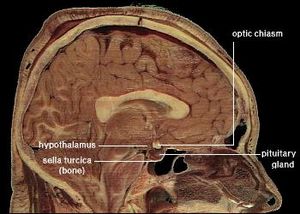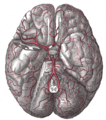Pituitary gland facts for kids
The pituitary gland is a super important part of your body's endocrine system. Think of the endocrine system as a team of glands that make and release special chemicals called hormones. These hormones act like messengers, telling different parts of your body what to do.
The pituitary gland is a tiny, pea-sized gland located at the base of your brain, right between your eyes. It's connected to another important part called the hypothalamus. Together, they control many vital body functions by sending out these hormone messages.
The pituitary gland has two main parts: the anterior pituitary (front part) and the posterior pituitary (back part). It's connected to the hypothalamus by a small stalk, sometimes called the 'infundibulum'. Even though the pituitary is often called the 'master gland' because it controls so many other glands, it's actually the hypothalamus that tells the pituitary what to do!
Contents
What Hormones Does the Pituitary Gland Release?
This small but mighty gland releases several different kinds of hormones, each with a special job.
Hormones from the Anterior Pituitary
The front part of the pituitary gland makes and releases many important hormones. These are controlled by signals from the hypothalamus.
- Adrenocorticotropic hormone (ACTH): This hormone is released when your body is under stress. It helps your body make more steroids, which are important for handling stress.
- Thyroid-stimulating hormone (TSH): TSH tells your thyroid gland (a gland in your neck) how much thyroid hormone to make. Thyroid hormones control your metabolism and energy levels.
- Growth hormone (HGH): This hormone is super important for growth! It helps your cells divide and grow, which is why you get taller and stronger as you get older.
- Prolactin (PRL): This hormone helps new mothers produce milk for their babies.
The anterior pituitary also produces two hormones called gonadotropins, which are important for puberty and reproduction:
- Luteinizing hormone (LH): In girls, LH helps trigger ovulation (when an egg is released). In boys, it helps make testosterone, a hormone important for male development.
- Follicle-stimulating hormone (FSH): FSH helps control development, growth, and puberty. It's also key for reproduction in both boys and girls.
Intermediate Lobe Hormone
There's a small part of the pituitary gland called the intermediate lobe. It produces one special hormone:
- Melanocyte-stimulating hormone (MSH): MSH helps control the production of melanin, which is the pigment that gives your skin and hair their color. It also plays a role in how hungry you feel.
Hormones from the Posterior Pituitary
The back part of the pituitary gland is actually an extension of the hypothalamus. It doesn't make its own hormones, but it stores and releases hormones that are made by the hypothalamus.
- Oxytocin: Most oxytocin comes from the hypothalamus. It plays a big role during and after childbirth, helping with uterine contractions. It's also involved in feelings of connection and bonding. Scientists are still learning all its functions!
- Antidiuretic hormone (ADH, also known as vasopressin): ADH helps your kidneys control how much water is in your body. It helps keep your body's water, glucose, and salt levels balanced, which is called homeostasis. It can also increase your blood pressure.
Oxytocin is interesting because it works in a "positive feedback loop." This means that when oxytocin is released, it causes more oxytocin to be released. For example, during birth, uterine contractions cause more oxytocin to be released, which then makes the contractions stronger. This loop continues until the baby is born.
Images for kids
See also
 In Spanish: Hipófisis para niños
In Spanish: Hipófisis para niños










